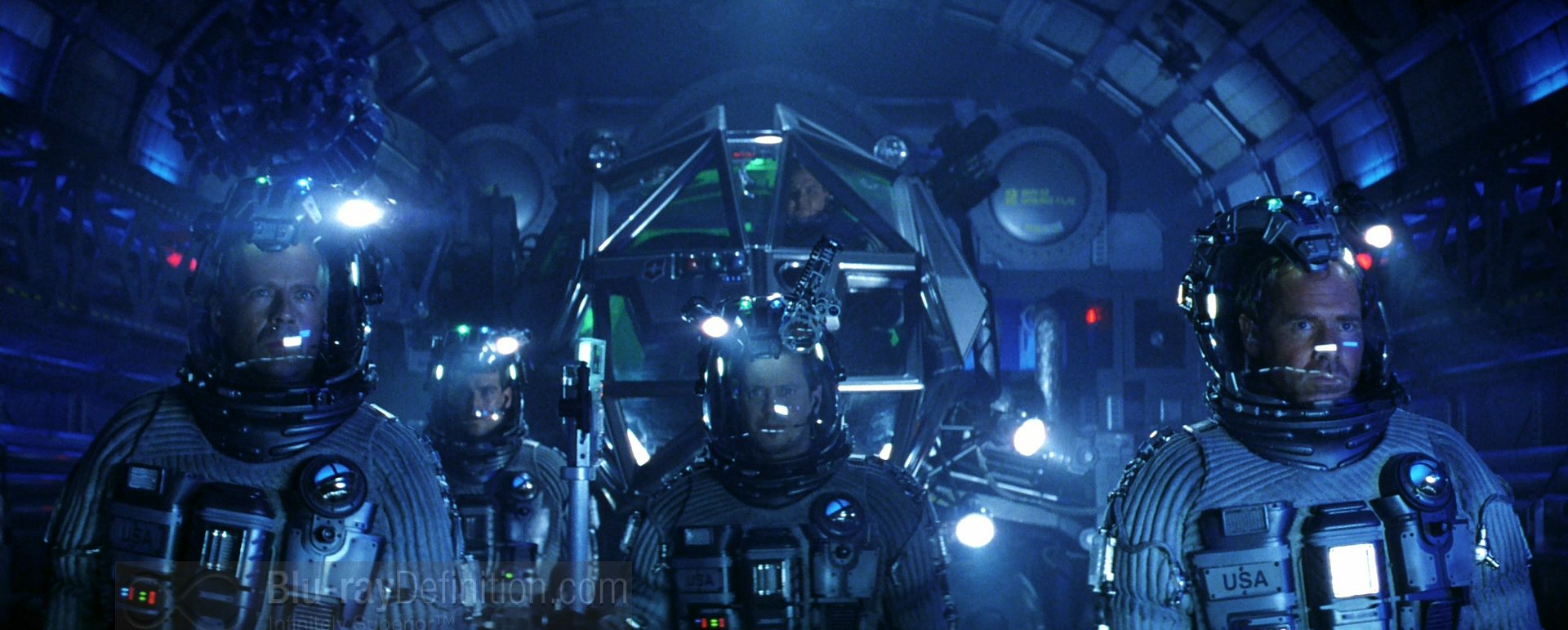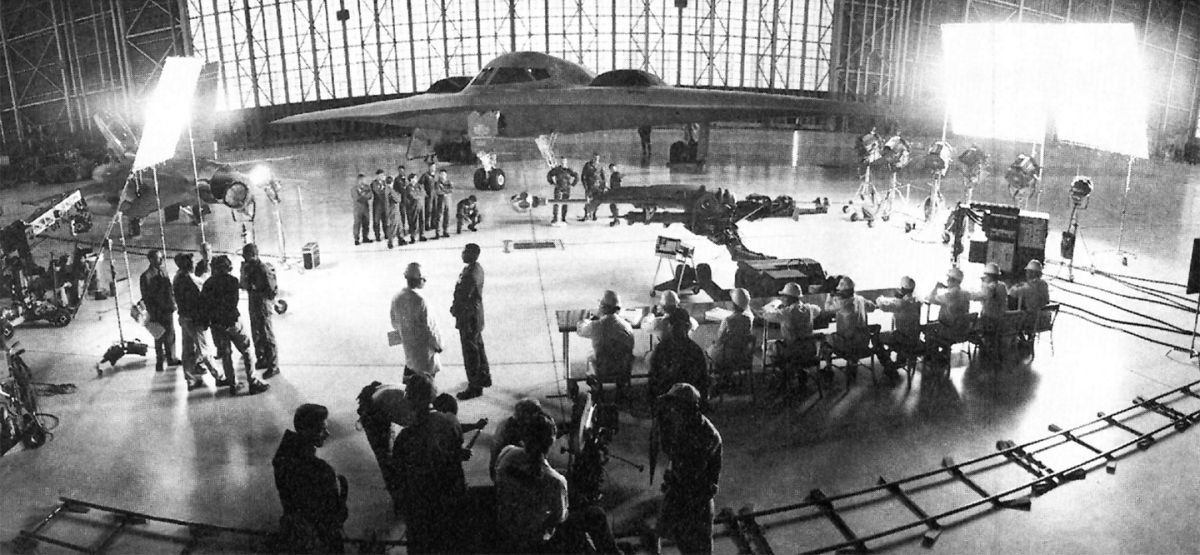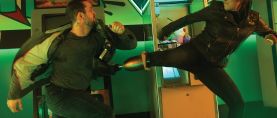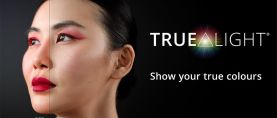
Armageddon: Reaching New Heights
John Schwartzman, ASC looks back at shooting director Michael Bay’s sci-fi action epic and how it has influenced him through the decades.
Unit photography by Frank Masi
In a world inundated with endlessly improving computer-generated effects, many of the visual effects of even the recent past already stand out to the eye of the modern viewer as fake, or worse, laughable. However, Armageddon, produced by Jerry Bruckheimer and directed by Michael Bay, stands out all the more for how real it still feels now, almost 25 years after its release.
Shot by John Schwartzman, ASC in 150 days over the course of 18 months, the apocalyptic action film took its production across the U.S., shooting on an oil rig in the Gulf of Mexico, the Badlands of South Dakota, and as the guest of NASA in both Florida at the Kennedy Space Center and in Texas at their Mission Control Center. Schwarzman maintains that the film feels real because much of what is portrayed on screen is real: “You can feel it. I really believe that’s where that texture in the movie comes from.”
Granted extensive access to NASA’s extensive facilities and what Schwarzman calls a “carte blanche” relationship with the studio — Touchstone Pictures — the crew’s creativity was limited only by the inability to shoot in actual space.
Armageddon marked the second feature collaboration between Schwarzman and Bay, following the hit action picture The Rock (1996). However, “I’d not only worked with Michael before — I grew up with him,” the cinematographer explains. “I’d known him since he was 9 years old. I shot his student films at ArtCenter College of Design, and then went on with him to do music videos and commercials at Propaganda Films. Then when we did The Rock, it was just a natural transition. I was Michael’s DP. Michael can be challenging, but I think because I’ve known him for so long, and since we grew up in the business together, I always knew what to expect.”
The run-and-gun production mentality that Schwartzman honed on music videos with Bay was integral to how he shot Armageddon, “We did things like go to Washington D.C. on a Sunday with a crew of five people and dolly track and cameras in a van. We literally bribed the Capitol Police with hats from The Rock that Michael signed to let us lay track inside the Capitol grounds to get shots of the Capitol Building. You couldn’t do that today. There’s no way. We were a run-and-gun little crew that went all around the country. For two weeks in prep, we’d go to a little town in Texas, and there’d be an old fire truck. We’d say, ‘Hey, why don’t you drive the fire truck down the street? We’ll put you in the movie.’ Everybody just kind of did it. It was unbelievable what we were able to sort of both achieve and get away with.”
While their shooting was quick-paced, it was extensively planned beforehand. Today, Schwartzman relishes the amount of pre-production time he was given on Armageddon to troubleshoot and plan, “Prep time is harder to come by these days, even on the movies that I do. Even on Jurassic World I had less prep time than I did on Armageddon. Part of that is also that Michael likes to move quickly. He doesn’t want to be bored with, ‘Why this isn’t working?’ It’s our job to figure out how to solve these problems [beforehand]. Let’s break the thing so we know how to fix it before we show up on day one. He had a lot of trust in me to do that.”
Much of the prep process for Schwartzman was spent at NASA, figuring out the logistics of filming Space Shuttle launches: “It was very complicated. We had to place the cameras before they start to fuel the main rocket. That’s usually 48 hours before. We had to deal with getting the NASA computers to turn our cameras on and off. There’s a two-mile fenced off area. Once they start to fuel the rocket, you can’t go in. You can’t change the exposure – you’re done. You just cross your fingers and hope you did it right.”


Shot with Panavision Panaflex cameras with C and E Series anamorphics, the Shuttle launch sequences thusly had to be meticulously planned. “NASA put me in touch with a photographer from the Orlando Sentinel, who had photographed every launch that NASA had done since 1962,” Schwartzman told American Cinematographer for a July 1998 cover story. “He was invaluable at telling me, ‘Okay, with 400 ASA film stock, it’s a four stop and 1/25 of a second before the rockets light up. Then it becomes an eight stop at 1/500th of a second.’ For the night launch we shot, we had two cameras next to each other, one set for prior to the engines lighting up and the other for when the engines lit up. There was no automatic exposure control back then. I mean, we’re talking completely analog.”
Looking back on the filming process, Schwartzman is proud of the technical and creative problem solving the whole crew exhibited, from figuring out how to remotely shoot the Space Shuttle launches to digging 30' under Disney Stage 2 to create the rocky wasteland of the asteroid surface. “It made everyone who was in a technical position, whether it was the costume designer, the production designer, the key grip, the gaffer, the camera department, have to rely on a lot of clever ways to solve problems,” He describes. “Fortunately, we had the time and the support to solve those problems. So that’s why people say, ‘I love that movie.’ There’s this great shot we ended up with, where I was praying that it was going to work because there was no other way to do it. I think it put everybody on their A game. There was no fixing later. We had to figure out how we were gonna make this.
Schwartzman is amazed by the lasting impact of Armageddon: “I shoot a lot of big studio movies now. When I sit down with the director for an interview, whether for Spider Man, or Jurassic World, they always talk about Armageddon. It’s amazing. I’d say if you’re 40, then that was a seminal movie. If you’re a 40-year-old director, that movie just stays. They love that movie. I mean, I sit and talk more about Armageddon in an interview with a director than anything else. I’m always amazed at how much they love it.”
Part of the appeal of the film for Schwartzman comes from the unimaginable access that the production had to NASA facilities at Johnson Space Center in Texas and Launch Complex 34 at the Kennedy Space Center in Florida. “We shot in what’s called the Neutral Buoyancy Laboratory where the astronauts train for missions in the world’s largest swimming pool,” Schwartzman recalls. “They actually allowed Ben Affleck and Bruce Willis to put on real spacesuits with real astronauts and go into the tank. We had a great line producer, Jim Van Wyck, who rented a wide-body jet. All our camera gear, everything, just went into the belly of the plane. When we flew to NASA, we landed on the runway where the Space Shuttle would land. We had that kind of just ease of movement. It was just spectacular. We filmed inside the Shuttle when it was in a building called the Orbiter Processing Facility, which is essentially where they clean up the toilets and put the food in and get it ready for the next mission.”
This kind of access did not happen by chance. “Part of it had to do with Jerry Bruckheimer,” Schwartzman notes, as the producer had made previous films with the cooperation if the U.S. military, including Top Gun. “While we were making Armageddon, [director] Mimi Leder was making Deep Impact. We were literally making them at the same time, two movies about asteroids, but they did not have the access that we had. I have to believe that was Jerry’s relationship with the government and the military. We had nothing but green lights everywhere we went — it was incredible. I spent a week living on an offshore oil rig for that opening sequence in the movie. The whole crew was flown out to an oil rig. There’s not there’s not an insurance company or lawyer in the world that would let that happen nowadays.”

Above all, reflecting on Armageddon, Schwartzman remembers the joy, both of making it and watching it: “The movie is fun. It’s over-the-top. I mean, the idea of oil drillers going onto an asteroid, obviously, you’re having to suspend a lot of disbelief. That said, if you strap in for the ride, I think it’s a really fun movie, and it delivers. It’s certainly not a serious movie, but it was a lot of fun to do.”
Schwartzman went on to shoot such features as Pearl Harbor — also directed by Bay — for which he was nominated for an ASC Award; Seabiscuit, for which he won an ASC Award and was nominated for an Academy Award; The Amazing Spider-Man; Jurassic World and his most recent hit, Jurassic World: Dominion.
If you enjoy archival and retrospective articles on classic and influential films, you'll find more AC historical coverage here.





